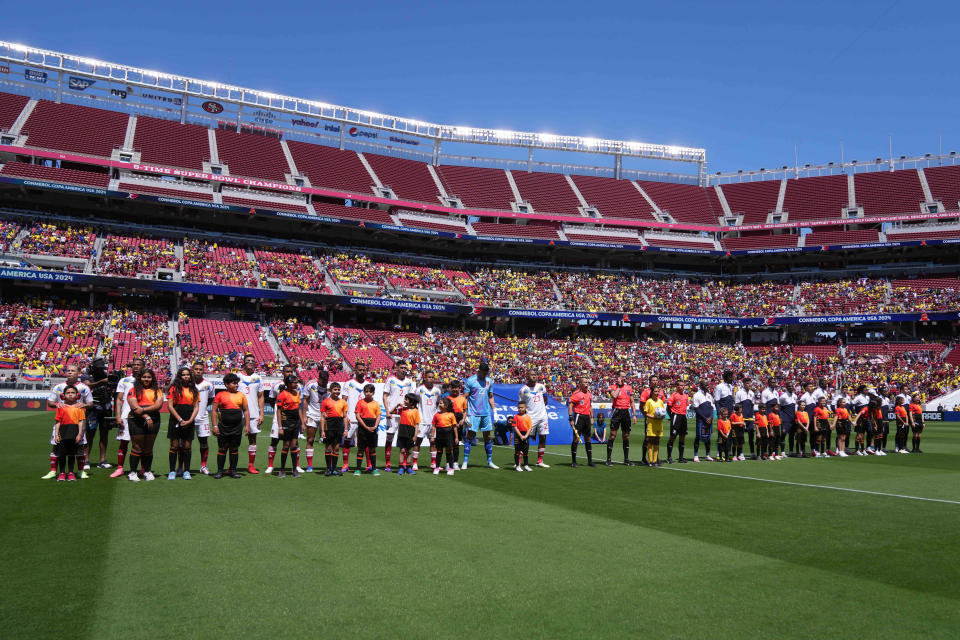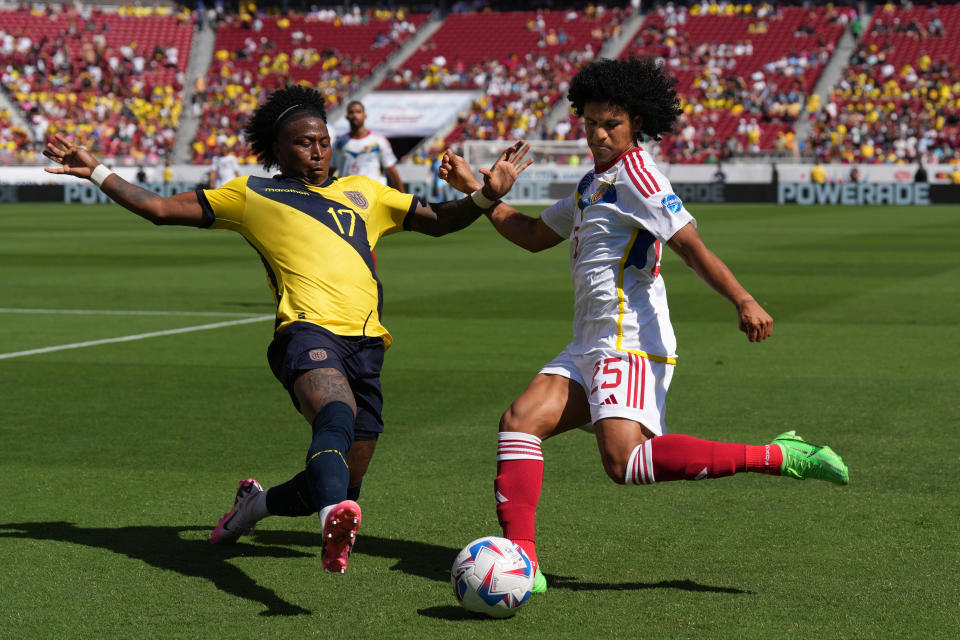Table of Contents
HOUSTON and ARLINGTON, Texas — You may have seen some damning photos floating on social media. Or maybe he just watched a 2024 Copa América match, caught a glimpse of the stands and wondered: Why aren’t there more people there?
Empty seats have been an intermittent feature of the early stages of the tournament. Fans have filled 71% of stadium capacity so far (and only 64% during the first six games). Everyone involved has promoted the Copa América as a competition on par with the Euro Cup, but its optics contrast sharply with the Euro Cup, where the stadiums are invariably full.
The simple question is: Why?
The not so simple answer is multiple.
It addresses ticket prices and marketing, but also broader macroeconomic issues, geography, urban planning and public transport and, possibly above all, the size of stadiums.
More seats, more empty
Through one round of group play, Copa América 2024 averages 51,592 fans per match, which is actually more than Euro 2024’s average attendance of 50,990 (across 28 group games; during only the first round of games, the Eurocup was 53,158).
However, simultaneous tournaments look different, partly because seven of the 10 German stadiums that will host Euro 2024 have capacity between 40,000 and 55,000 people; Meanwhile, the Copa América is mainly played in NFL stadiums with a capacity of between 60,000 and 80,000 spectators.
The next question, of course, is: Why hasn’t that extra capacity been taken advantage of?
At the Euro Cup, more than 97% of the seats have been filled and more could be filled if the stadiums were larger.
Instead, in five of the eight Copa América matches so far, tens of thousands of seats have been empty.
Ticket prices
Two reasons for those divergent results are ticket prices and the uniquely American, oppressively capitalist obsession with income.
The average price of a ticket to the Copa América, according to multiple estimates, has exceeded $200. Even the cheapest seats at many Cup games cost more than $100. As of Tuesday morning, tickets still available for the Argentina-Chile game at MetLife Stadium in New Jersey cost more than $500 on the primary market.
The culprit is dynamic pricing, a Algorithmic scheme by which prices fluctuate according to demand, so that sellers and event organizers can maximize their profits..
In euros, as in the rest of the world, prices are fixed. Group stage tickets vary from €30 ($32) to €200 ($215) for non-premium seats. (“Prime” seats cost €400). The range increases to €50-250 for the round of 16, €60-300 for the quarter-finals, and so on.
This approach leaves revenue on the table; demand exceeds supply. (UEFA, which runs the European Championship, said it received more than 20 million ticket requests.) But it generates and maintains relative goodwill among fans; First of all, it is one of the reasons for the overwhelming demand. It also helps ensure that the stadiums are full, which contributes to the spectacle and overall appeal of the tournament.
This, critics say, is what several American soccer entities fail to understand. They view ticket sales primarily, and sometimes solely, through the lens of revenue. They apparently see little difference between selling 30,000 tickets at $200 each and selling 60,000 tickets at $100 each, despite the medium and long-term benefits of the latter: the thousands more people who can enjoy the sport; and the millions of spectators who watch a full stadium on television, which sends a very different message than a half-empty one: This is a game worth looking out for.
CONMEBOL, the South American soccer confederation, typically controls all ticket sales for the Copa América, as does UEFA for the Euro. But for this 2024 tournament in the United States, it has handed over sales to individual stadiums and its partners, whether Ticketmaster or Seatgeek. None of those entities have any interest in growing the sport of soccer. That is why they have used dynamic prices and everyone involved, from the runners to the stadiums, CONMEBOL and CONCACAF and Even the US Soccer Federation. – will get a cut of the profits, while fans’ wallets bleed.

Expenses go beyond tickets
Another reason the Copa America venues haven’t filled up is that simply getting to them can be expensive.
Even for locals, many NFL stadiums are inaccessible by public transportation, unlike most European soccer fields. Then you have to pay to park. You’ll probably spend obscene amounts on drinks or food. The costs add up.
However, they are especially prohibitive for the Copa América’s primary audience: soccer fans in South America.
All but one of the Euro 2024 participants are within 1,000 miles of Germany. In fact, eight of 23 share borders with the host country. On the other hand, all South American countries are further more than 1,000 miles from every continental US city. Most are within 2,000 miles of the America’s Cup host cities. While Hungarians can get to Germany for $30, an Argentinian wanting to travel to New York would normally have to spend more than $1,000 on round-trip airfare.
Oh, and 1,000 dollars for a middle class Argentine is a lot more so than for a middle-class American (or a Brit or a Dane). The strength of the dollar and the US economy, compared to struggling South American economies, often makes summer vacations in the United States unfeasible. (Obtain a B2 visitor visa It can also be extremely difficult, and require a wait of months or even years.)
Still, thousands of South Americans have traveled for Copa América 2024. Juan Emilio Roa, CONMEBOL’s commercial chief, told Yahoo Sports before the tournament that around 25% of the fans attending the matches would be foreigners. Travel agencies offered all-inclusive packages, including tickets that were exempt from the dynamic pricing system.
However, the distance and cost of travel (to the United States and within that country, between the 14 host cities) surely kept many more thousands of fans at home.
Different teams, different countries, different audiences.
The target audience for the 2024 Copa América in the stadium, then, has been the American public, and especially the diverse and vibrant Latin communities spread throughout the United States.
However, Latin American diasporas are not evenly distributed. There are more than 37 million Mexican Americans. There are more than 2 million Colombian Americans. But there are less than 100,000 Uruguayans and Paraguayans here in the United States, according to census data.

Their national soccer teams also enjoy varying levels of popularity. Therefore, the demand for tickets has varied from match to match. Colombia attracted 67,059 in Houston on Monday. Argentina sold out the Mercedes-Benz Stadium in Atlanta. But when Venezuela and Ecuador met in Santa Clara, California, the stands at Levi’s Stadium were mostly empty. The same happens with Uruguay and Panama in Miami.
The most curious attendance figure was 53,763 spectators for Mexico vs. Jamaica, about 18,000 less than the capacity of Houston’s NRG Stadium. It was probably a function of ticket prices, El Tri’s losing streak and fatigue.
Market fatigue?
In the lead-up to this Copa América, several industry sources speculated with Yahoo Sports that organizers were struggling to distinguish this tournament from the rest of a crowded soccer market. Most participating teams regularly play friendlies in the US. All six CONCACAF teams have played in Gold Cup and Nations League finals. The United States and Mexico played a final at AT&T Stadium in Arlington, Texas, just three months before the United States opened the Copa América there against Bolivia.
“It’s a little strange going back to the same places,” American midfielder Tyler Adams admitted on Sunday.
And even for him, as a player who understands the prestige and importance of the Copa América, “it still doesn’t feel very different (from a Nations League final),” Adams said.
If he doesn’t think it’s any different, does a casual fan understand that it’s actually more meaningful?
However, Adams added: “Our fans showed up today.” There were 47,873 in the 80,000-seat stadium, many of them dressed in red, white and blue. “And I was happy with that,” he said. However, he hopes that “we’ll have some big games ahead of us,” and that they will feel more distinct, with even bigger audiences.


